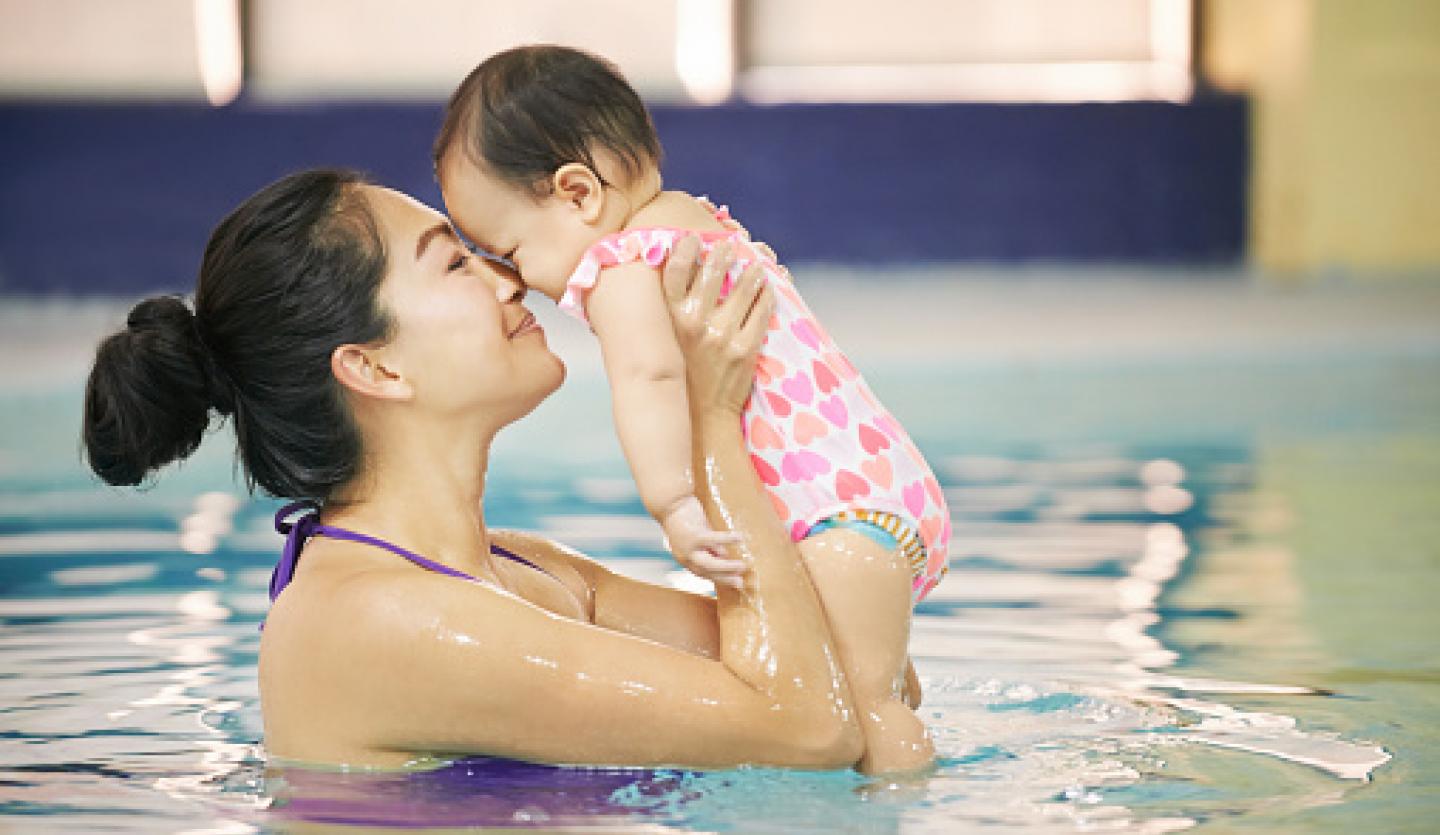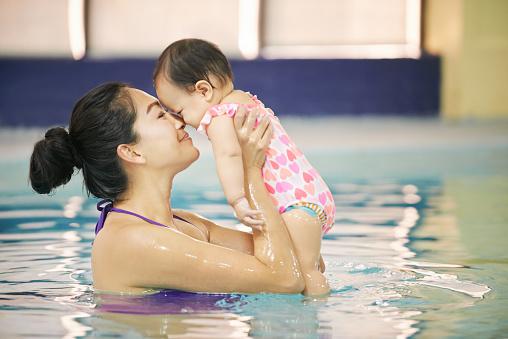Nothing reminds us of summer more than visions of a baby or young child splashing around in a kiddie pool. Yet water brings with it many dangers. Drowning is a leading cause of death among children, including infants and toddlers. Following these guidelines can help you keep your child happy yet safe.
Babies and young children are naturally drawn to shiny, sparkly water which moves, shakes and is fun to touch and splash. Most infant drownings occur in bathtubs and buckets. Toddlers between one and four years most commonly drown in swimming pools.
The key to keeping your child safe is constant supervision. For infants and children through four years of age, parents and caregivers should never—even for a moment—leave children alone or in the care of another child while in or near bathtubs, pools, spas, wading pools, or near irrigation ditches or other open bodies of water. Children of this age practice “touch supervision,” meaning that a supervising adult should be within arm’s length of the child with full attention focused on them at all times. The adult should not be engaged in distracting activities, such as talking on the telephone, socializing or tending to household chores.
Safety Around the House
Never leave a container such as a bucket with even a small amount of liquid unattended. When finished using a container, empty it immediately. Do not leave empty containers outside in the yard or around the house where they may accumulate water and attract young children. Other items that contain liquids that may be hazardous are toilets, sinks, coolers, fish tanks, and landscape ponds.
Bath Safety
- Do not leave a baby unattended for even a second. If you need to leave the bathroom, take the baby with you. Do not rely on older children to watch the baby for you.
- Before bathing your child, have all supplies within arm’s reach and before you.
- Baby bathtubs are not substitutes for supervision. They are only bathing aids, not safety devices.
- Always stay within arm’s reach when the child is in the bathtub.
- Never leave a child unattended while filling the bathtub; always empty bath water immediately after use. Babies can drown in as little as one inch of water.
- Test water temperature with your elbow or a thermometer. The temperature should be between 90 and 100 degrees Fahrenheit.
- Consider placing a latch on the bathroom door to keep children out of the bathroom when unsupervised.
- Keep the toilet lid down to prevent access to the water, and consider using a toilet seat lock to stop children from opening the lid.
Pool Safety
- Never leave children alone in or near the pool or spa, even for a moment. An adult who knows how to swim and perform CPR should be within arm's length.
- Install a fence at least four feet high around all four pool sides. The fence should not have openings or protrusions that a young child could use to get over, under, or through. Chain-link fences are easier to climb and should be avoided. The safest fence is one that completely separates the pool from the house and yard. If the house serves as the fourth side of the fence, install an alarm on the exit door to the yard and the pool. For additional protection, install window guards on windows facing the pool. Drowning victims have also used pet doors to gain access to pools. Keep all of your barriers and alarms in good repair with fresh batteries.
- Make sure pool gates open out from the pool, and self-close and self-latch at a height children cannot reach. Consider alarms on the gate to alert you when someone opens the gate. Consider surface wave or underwater alarms as an added layer of protection.
- Keep rescue equipment—a shepherd's hook (a long pole with a hook on the end) and life preserver—near the pool. Choose a shepherd's hook and other rescue equipment made of fiberglass or other materials that do not conduct electricity.
- Keep a portable telephone near the pool to call 9-1-1 in an emergency quickly.
- Avoid inflatable swimming aids such as "floaties." Such devices can suddenly shift position, lose air or slip out from underneath a child. They are not a substitute for approved life vests and can give children and parents a false sense of security.
- Enroll your child in swimming lessons or a water safety course. Children over age one may be at a lower risk of drowning if they have had some formal swimming instruction. However, there is no evidence that swimming lessons or water survival skills courses can prevent drowning in babies younger than one year of age. Remember that swim programs should never be seen as "drown-proofing" a child of any age.
- Avoid entrapment. Suction from pool and spa drains can trap a swimmer underwater. Body parts and hair can become entrapped by the strong suction. Do not use a pool or spa if there are broken or missing drain covers. Ask your pool operator if your pool or spa's drains comply with the Pool and Spa Safety Act. If you have a swimming pool or spa, ask your pool service representative to update your drains and other suction fitting with anti-entrapment drain covers and other devices or systems.
- Parents and caregivers should take an infant and child CPR (cardiopulmonary resuscitation) course. Knowing these skills is important around the water. It is a simple step that can save your child’s life.
- Large, inflatable, above-ground pools are popular for backyards. Children may fall in if they lean against the soft side of an inflatable pool. Although such pools are often exempt from local pool fencing requirements, they must be surrounded by an appropriate fence, just as a permanent pool would be, so that children cannot gain unsupervised access.
- Remove all toys from pools when not in use to avoid children being tempted to get them.
- Hot tubs pose drowning and overheating risks to very young children. Always secure safety covers and barriers to prevent children from accessing spas or hot tubs when not in use. Don't allow water to collect on top of the pool or hot tub cover.
- Empty inflatable pools after each use.
If a child is missing, always look in the pool or spa first!
See these additional articles of interest from the American Academy of Pediatrics:
- Infant Water Safety: Protect Your New Baby From Drowning
- Swim Lessons: When to Start and What Parents Should Know
Call 866-MY-LI-DOC (866-695-4362) to find a Catholic Health physician near you.



